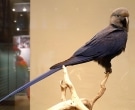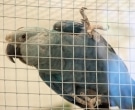Content |
|---|
Description:
55 to 57 cm.. length and 360 g. of weight.
The Spix's Macaw (Cyanopsitta spixii) has various shades of blue. The head is pale-blue, the wings and tail dark blue. The underside of wings and the tail are black. They have a naked skin in the face grey / Black which sometimes fades to white and white when they are underage.
Bill is completely black, except in the youth having a clean white stripe in the center of the bill. The white band of the bill and the white skin of the face of the youth disappears after 6 months.
The legs are pale grey when they are juveniles, being dark grey, almost black when they are of adults.
The eyes they are dark in the youth, but they fade to white when mature birds.
- Sound of the Spix's Macaw.
Habitat:
Information on the natural ecology and behavior of these birds is limited., now that research not started until they were nothing more than 3 known birds those that lived in the wild.
But, there are records in which they are associated with gallery forests dominated by Tabebuia seasonal streams to grow along (streams) in the area caatinga (Thorn scrub semiarid community).
There are reports of the Spix's Macaw inhabiting sheets closed or more common in caatinga habitats (that is to say, that they do not have trees Tabebuia caraiba). Opinions that the species is ecologically linked with palms Mauritia flexuosa left without support and, in view of the wide availability of these habitats, seems totally unlikely.
When a few birds were discovered in 1980, These showed a strong herding behavior. These and the remaining birds, showed strong habitual features, using for example, hangers in the bare branches at the top of the tall trees, making particles and daily flight routes to nesting sites (one of those places, according to reports, was used continuously during 50 years), the last Spix's Macaw which data have, they were strongly linked with the Blue-winged Macaw.
According to reports, sometimes, obsrvados sleeping on top of a cactus, for example, of the species Cereus squamosus.
Reproduction:
In the wild, the Spix's Macaw They nest in tree hollows, most frequently in Tabebuia caraiba mature, at least to several meters above the ground.
the brood, in general, is between the months of November-March may vary in relation to the calendar and the intensity of the rains.
The intercourse lasts usually between 2 and 3 minutes and is done with two birds staying together on a perch with one of the legs of the male (usually right) mounted on the rear of the rump of the female.
It is believed that the normal clutch size in the wild had three eggs. But, in captivity the most common clutch size is four and can range from one to seven. An average egg is of 40 mm x 30 mm and weighs some 20 g.. They lay an egg oval-shaped and white.
The incubation period is of 25-28 days and only the female performs incubation tasks. The females are fed by the male, both within the nest, and outside the nest. The chicks hatch mostly naked with a small amount of cover at the bottom. The emplumamiento occurs in approximately 70 days and captive birds, bred by hand, they tend to become independent between the 100 and 130 days.
Food:
The diet of the Spix's Macaw wild included seeds of Cnidoscolus quercifolius and Jatropha mollissima, seeds and fruits of Melanoxylon, fruits of Maytenus rigida and Ziziphus Juazeiro, and possibly nuts of palmas Syagrus coronata, although the latter probably too strong and large for the relatively delicate beak.
Distribution:
Size of the area of distribution (reproduction / resident): 50 km2
The Spix's Macaw they were endemic in the northeast of Brazil, mainly in the State of Bay, but also from Pernambuco. There they lived in a large expanse of semi-arid territory known as the Caatinga. Within the Caatinga There are micro-habitats, one of which – the Caraibeira Riparian Woodland, was the home of the Spix's Macaw. This particular habitat area is located near a small, charming town called Curaca, conveniently located along somewhere in the san francisco river. One of the tributaries that feed to the san francisco river is the Melancia Creek and it is through this waterway, where can I find the ancient habitat of the Spix's Macaw.
The Caraibeira (Tabebuia caraiba) It is the dominant tree species occurring along the banks of the Melancia Creek; It was also the most important tree species for the Spix's Macaw, Since it provided nesting hollows, shelter and food for the species.
Possibly previously ranged in one much larger Northeastern area of Brazil, that covers much of the region of the ‘Gerais‘ including the South of maranhão, to the northeast of Goiás, Southwest of Piauí and North of Bay, but reports from some of these areas are apparently based on finger-pointing and even erroneous information provided by bird hunters.
Conservation:
• Current Red List of UICN: Critical Hazard – Possibly extinct in the wild
• Population trend: Unknown
The Spix's Macaw It may not be the largest or most colourful species of macaws but is the Parrot with more critically endangered in the world, no known wild specimens(UICN, 2004).
While this species exists captive in various populations, the last known individual in the wild disappeared in late 2000, mainly as a result of the capture for the bird trade Wild addition by the habitat loss. But, cannot yet be presumed extinct in the wild until all potential areas of habitat have been thoroughly reviewed.
Any remaining population is likely to be small, and for these reasons the Spix's Macaw It is treated as a species in critical hazard (possibly extinct in the wild).
TRIVIA:
-
– One of the last Spix's Macaws dies
– The true story of the "Rio" macaw
– The history of Presley (A Spix Macaw who lived for twenty-five years in a small cage of some 60 x 60 centimeters in the living room of a house in Colorado, U.S.A.) – washingtonpost
"Spix's Macaw" in captivity:
Some suggest that there may be up to 120 These beautiful birds in private collections – the exact number is unknown. But, what is certain is that these last Spix's macaws survivors are among the most valuable and protected birds in the world.
Its longevity is estimated between 20-30 years in the nature and 20-40 years in captivity. Latest Spix's Macaw known wild had at least 20 years of age, at the time of his disappearance. There are two Spix's macaws in captivity who were born in 1976 and these are the Macaws oldest registered species.
Alternative names:
– Spix’s Macaw, Little Blue Macaw (English).
– Ara de Spix (French).
– Spixara, Spix Ara, Spix-Ara (German).
– Ararinha-azul (Portuguese).
– Ararinha-azul (Portuguese (Brazil)).
– Guacamayo de Spix, Maracaná Azul (español).

scientific classification:
– Order: Psittaciformes
– Family: Psittacidae
– Genus: Cyanopsitta
– Scientific name: Cyanopsitta spixii
– Citation: (Wagler, 1832)
– Protonimo: Sittace Spixii
Images Spix's Macaw:
“Spix's Macaw” (Cyanopsitta spixii)
Sources:
- Avibase
- Parrots of the World – Forshaw Joseph M
- Parrots A Guide to the Parrots of the World – Tony Juniper & Mike Parr
- Birdlife
- TO THE WABRA WILDLIFE PRESERVATION
-
Photos:
(1) – A Spix's Macaw in Vogelpark Walsrode, Walsrode, Germany in about 1980 By Rüdiger Stehn from Kiel, Deutschland (71 Spix-Ara) [CC BY-SA 2.0], via Wikimedia Commons
(2) – A juvenile in captivity. Note white stripe along top of beak and pale-grey bare facial skin By The original uploader was Robert01 at German Wikipedia(Original text: Robert01) (Self-photographed) [CC BY-SA 2.0 of], via Wikimedia Commons
(3) – Exhibit in Museum of Natural History, Berlin, Germany. Photography was permitted in the museum without restriction By Daderot (Own work) [CC0], via Wikimedia Commons
(4) – guacamayo de Spix (Cyanopsitta spixii) por Lycaon – Fauna extinta recientemente, redescubierta, nuevas especies – ellinceiberico
(5) – Cyanopsitta spixii – Parrot-birds
(6) – An 1878 painting of an adult by Joseph Smit [Public domain], via Wikimedia Commons
- Sounds: Juan Mazar Barnett (Xeno-canto)







